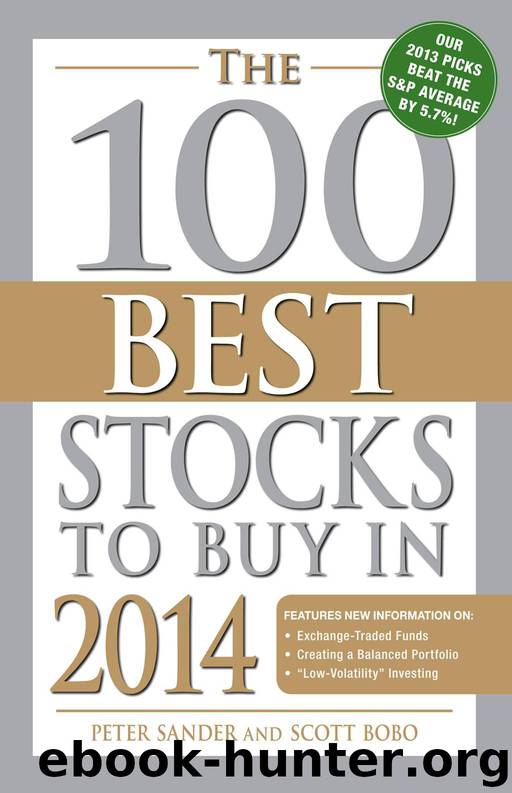The 100 Best Stocks to Buy in 2014 (100 Best Stocks You Can Buy) by Peter Sander & Scott Bobo

Author:Peter Sander & Scott Bobo [Sander, Peter]
Language: eng
Format: mobi
ISBN: 9781440566295
Publisher: Adams Media
Published: 2013-10-07T14:00:00+00:00
View a text version of this table
The Kroger Company
1014 Vine Street
Cincinnati, OH 45202
(513) 762-4000
Website: www.kroger.com
AGGRESSIVE GROWTH
Macy’s, Inc.
Ticker symbol: M (NYSE) S&P rating: BBB- Value Line financial strength rating: B+ Current yield: 2.0% Dividend raises, past 10 years: 5
Company Profile
Macy’s is now by far the largest operator of department stores in the U.S. The company operates under 2 brand names, Macy’s and Bloomingdale’s, and operates about 850 stores in 45 states, Puerto Rico, and Guam. Macy’s has been assembled over the years from a large assortment of famed department store predecessors including Marshall Field, May, and a portfolio of names once under ownership of Federated Department Stores, including Lazarus, Weinstocks, Dillard, Abraham & Straus, I. Magnin, and others. The company, in current form, was assembled after Federated emerged from bankruptcy in 1992.
In addition to department stores, Macy’s operates its own credit card operations and an internal merchandising group that, among other things, develops and markets a number of familiar proprietary brands such as Charter Club, Club Room, Hotel Collection, Tommy Hilfiger, Ellen Tracy, and now, the Martha Stewart Collection. Private label brands now account for 19 percent of sales. The company also operates 90 specialty stores including outlets and furniture stores. The online presence, macys.com, continues to grow and is strategically more integrated with the sales process. It’s easy to shop online, then see the product, pick it up, and importantly, pay the online price at the store. The sales mix is approximately 62 percent women’s clothing, shoes, and accessories; 23 percent men’s and children’s; and 15 percent home and miscellaneous.
Financial Highlights, Fiscal Year 2012
Macy’s continues to ride a combination of economic recovery and a series of internal operational improvements to find a successful new growth trajectory in a business that many had given up on. Same-store sales improved 3.3 percent, which is somewhat diminished from last year’s 5.3 percent but on a stronger “comp” base. Almost all of this growth is accounted for by online sales, which advanced over 40 percent during the year, for the second year in a row, almost double the increases experienced in previous years. Total sales advanced about 4.7 percent to $27.7 billion, finally exceeding the boom years prior to the recession. Operational improvements in procurement and supply chain, combined with improved and more locally customized merchandising and improved profitability from its proprietary credit card, grew net profit margins back to 5.0 percent after reaching 4.7 percent in FY2012, and a continued nice recovery from the recessionary levels of 2–3 percent. It makes sense now to compare Macy’s results to stronger years, and indeed for the past 10 years the 5.0 percent net profit margin level was only achieved once, in 2005. Most of the increase has come from operating costs, not gross margin improvements, suggesting that retail price competition (and discounting) are still substantial. The company continues to invest in itself, buying back almost $1 billion in stock in the first 9 months of FY2012 and authorizing $1.5 billion for future buybacks. The company
Download
This site does not store any files on its server. We only index and link to content provided by other sites. Please contact the content providers to delete copyright contents if any and email us, we'll remove relevant links or contents immediately.
The Compound Effect by Darren Hardy(8524)
Tools of Titans by Timothy Ferriss(7825)
Nudge - Improving Decisions about Health, Wealth, and Happiness by Thaler Sunstein(7261)
Win Bigly by Scott Adams(6832)
Deep Work by Cal Newport(6587)
Rich Dad Poor Dad by Robert T. Kiyosaki(6191)
Pioneering Portfolio Management by David F. Swensen(6089)
Principles: Life and Work by Ray Dalio(5984)
The Barefoot Investor by Scott Pape(5598)
Digital Minimalism by Cal Newport;(5397)
Grit by Angela Duckworth(5302)
The Slight Edge by Jeff Olson(5203)
Discipline Equals Freedom by Jocko Willink(5160)
The Motivation Myth by Jeff Haden(5010)
You Are a Badass at Making Money by Jen Sincero(4658)
The Four Tendencies by Gretchen Rubin(4428)
Eat That Frog! by Brian Tracy(4166)
The Confidence Code by Katty Kay(4043)
Bullshit Jobs by David Graeber(3843)
